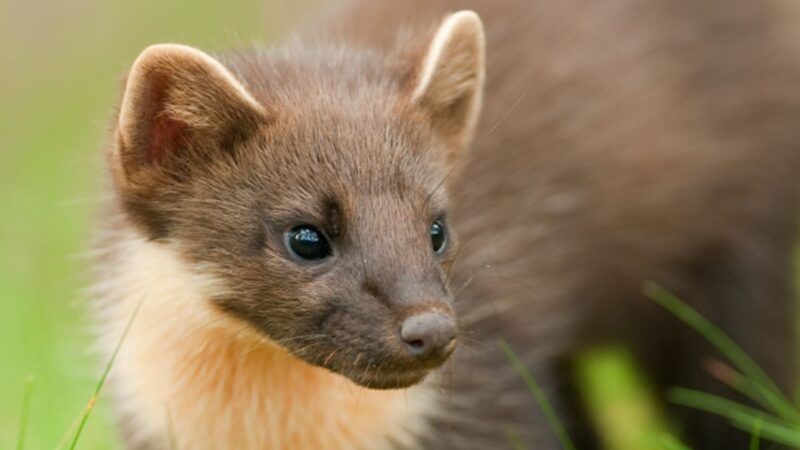As part of the Two Moors Pine Marten Project, 15 pine martens were released into eastern Dartmoor last September, with the reintroduced animals dispersing across South Devon, including the Haldon Forest area.
Pine martens have large territories and move quickly through the landscape covering large distances, which can bring them into contact with roads and fast-moving traffic – the highest risk factor for this species in the UK.
In order to understand where the returning pine martens cross the road network, and in an effort to protect the newly reintroduced species, National Highways, Devon Wildlife Trust, Animex International and Devon County Council have installed cameras in locations around the A38 and A380, and are advising drivers to be wary of animals crossing around the Haldon Forest area.
As this video footage shows, conservationists at Devon Wildlife Trust recently celebrated the first births of pine marten kits in a pioneering reintroduction project which has returned the species to the South West of England after a 100-year absence.
Sadly, though, a small number of pine marten deaths have been recorded on Devon’s roadsides in recent months, prompting action to monitor the animals’ crossing movements.
Ben Hewlett, National Highways’ Senior Environmental Advisor, said: “While roads have always connected people and places, they are too often a barrier for nature, severing habitats and contributing to the decline in biodiversity. At National Highways, we are committed to protecting and enhancing the ecology and environment around our road network, whether that be nationally or regionally.
“And to assist our conservation partners in Devon, we are working with them to identify any movement patterns of the recently released pine marten population, which could help pinpoint any mitigations needed in the long term.
“This particular area is abundant with wildlife, such as deer, otters and dormice, and we’d also like to raise awareness with the travelling public making their journeys along these routes – for their own safety and the safety of wildlife in these locations.
“Animals can use culverts under our roads, and by installing cameras, we can help to plot their movements and record particular locations where they are likely to look for crossing points.”
Councillor Jacqi Hodgson, Cabinet Member for Climate Change and Biodiversity, said:
“The return of pine martens to Devon through the Two Moors Project is a major step forward in restoring our native wildlife and ecosystems.
“We’re pleased to be supporting this important work and to be part of the collaborative effort to better understand how these animals are navigating landscapes near major roads.
“Making the A380 and all of our road network across Devon safer for wildlife is vital not only for the long-term recovery of pine martens, but for many other species, including the much-loved native red squirrels as well.”
The Two Moors Pine Marten Project, led by Devon Wildlife Trust, is a partnership between Dartmoor National Park Authority, Devon Wildlife Trust, Exmoor National Park Authority, Forestry England, National Trust, Somerset Wildlife Trust and Woodland Trust with support from the National Lottery Heritage Fund.
The project aims to bring back pine martens to the South West region, benefitting their woodland homes and engaging people in woodland wildlife and the Dartmoor release will be followed by a second release in Exmoor in the autumn.
Pine martens play a crucial role in our woodlands. As a predator focussing on easy to find, easy to catch prey, they maintain a check on common abundant animals that leaves space for rarer species to thrive. Extinct in the South West for 150 years, caused by habitat loss and persecution, the road network has been built in their absence, providing a new challenge for pine martens in moving through the landscape.
The Pine Marten Highways project is exploring how pine martens cross our main road network, with the view to installing safe crossing structures in key high-risk areas, and the first phase of the initiative involves the installation of camera traps at key sites to understand where and how martens cross the road.
Ed Parr Ferris, Conservation Manager for the Devon Wildlife Trust, said: “Pine martens returning to the South West is an exciting demonstration of how we can reverse nature’s decline.
“But we have altered our landscapes tremendously and we need to keep finding solutions to give wildlife the ability to thrive. We know that wildlife will cross roads safely using culverts, underpasses and bridges, where they are available and easy to find and use.
“This project will identify where and how pine martens and other wildlife are crossing our roads, with the view to installing safe crossing options at the highest risk locations.
“In the meantime, we can all do our bit to help wildlife on our roads by being aware of places that are important for wildlife, like Haldon Forest, and slow down, especially if driving at night, dusk or dawn when wildlife are most likely to cross the road.”
Alongside the pine marten initiative, and as part of a Network for Nature partnership, National Highways has also invested in Devon Wildlife Trust’s Creating Species Highways project, an initiative aimed at developing a strategic approach to safe wildlife road crossings.
National Highways – through its Designated Funds programme – has also enabled:
· the creation of new fish passes alongside the A38 in Devon;
· improved water quality at Stover Country Park in Devon.
For more information on Devon’s pine marten project, people can visit the Devon Wildlife Trust web page.

